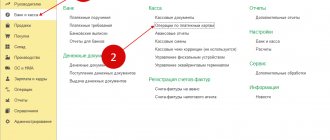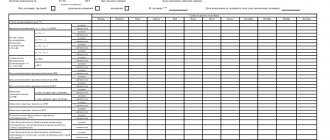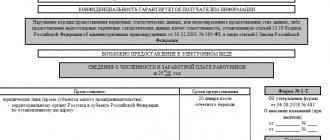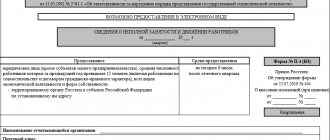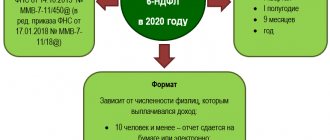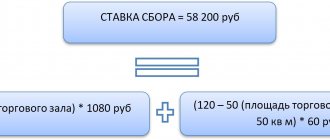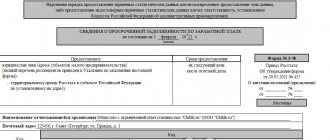When is a certificate of return of funds to the buyer drawn up?
Situations when a buyer wants to return a purchased product arise quite often.
The possibility of such a return is provided for by the Law “On the Protection of Consumer Rights” dated 02/07/92 No. 2300-1. Before the transition to online cash registers, the procedure for the cashier and company management depended on whether the buyer paid at the cash register in cash or by card, as well as on the moment of return (on the day of purchase or later).
For more information about what requirements must be observed when working with cash, see the material “Cash discipline and responsibility for its violation .
If the buyer paid in cash and returned the goods on the day of purchase, the fact of the buyer’s return of money to the seller was formalized using the unified form KM-3, called “Act on the return of money to buyers (clients) for unused cash register receipts (including erroneously punched cash register receipts). checks)". On the check, a representative of the store administration had to put his authorization signature as the basis for issuing cash from the cash register. The check was pasted on a separate sheet and, together with the KM-3 act, was transferred to the accounting department.
ConsultantPlus experts explained in detail how to correctly process the return of goods from the buyer and return the money from the cash register. Get free demo access to K+ and go to the Ready Solution to find out all the details of this procedure.
Let's take a closer look at filling out the KM-3 form.
Return via online checkout the next day
The procedure for returning funds from the cash register does not depend on when the goods are actually returned. The buyer writes an application for the return of goods and money, and the seller draws up documents for their return. After this, a check with the sign “return of receipt” is punched.
| Return via online checkout | What does it include |
| 1. Statement from the buyer | To return the goods, the buyer must have the purchase receipt and his passport with him. The buyer writes the application in any form, but sometimes stores print ready-made forms for such applications in advance. After this, the cashier checks the data in the receipt and the buyer’s passport. For the Federal Tax Service, the statement will be confirmation that the seller actually returned the money to the buyer, and did not just take it from the cash register for personal use. |
| 2. Registration of an invoice for the return of goods | There is no special invoice form used to return the goods, so the seller can develop it independently. Two copies of this invoice are prepared, which are signed by both the buyer and the seller. |
| 3. Printing a receipt for the return of goods at the checkout | After all the above steps, the seller generates a return receipt. It differs from a regular check in that the field for the payment attribute will indicate “receipt return” and not “receipt”. |
| 4. Issuance of funds to the buyer | After preparing and signing the necessary documents, the buyer will be returned the funds he previously paid. |
We fill out the act form KM-3
Act KM-3 was drawn up in 1 copy by a commission consisting of the head of the department, senior cashier and cashier and approved by the head. It was necessary to fill out information for all canceled checks, as well as for checks returned by customers in cases where they returned goods. Cash proceeds for that day were reduced by the amount returned to customers, and an entry was made about this in the journal of the cashier-operator KM-4.
It was not necessary to draw up a KM-3 act in all cases of returning goods. If the buyer paid with a bank card, it was impossible to give him money from the cash register when returning the goods, since this direction of spending cash proceeds was not provided for by regulatory documents (clause 2 of Bank of Russia Directive No. 3073-U dated October 7, 2013 on spending cash from the cash register) . An act was not drawn up in the KM-3 form even if the goods were returned not on the day of purchase. In this case, at the request of the buyer, the return of the goods, paid for in cash, was carried out on the basis of his application from the main cash register using a cash receipt order.
Instructions for filling out the KM-3 act
This document must be drawn up in one copy by an established commission consisting of:
- The head of a company or structural unit (for example, a store);
- Head of department (manager);
- Senior shift cashier;
- Cashier.
We present the completion of the act in the form of a table:
| p/p | Intelligence | A comment |
| 1 | Company or division registration details | Indicated in the header of the act and consist of the name in accordance with the registration documents, TIN, contact information |
| 2 | Information about CCP used in the organization | Make, model, numbers (registration and factory) |
| 3 | Filling period | Indicate the date of drawing up the act |
| 4 | Serial number | Indicated depending on the number of check grounds |
| 5 | Check number and amount | The cashier learns this information from the cash receipt |
| 6 | Person who authorized the return | You must indicate your position and full name |
Filling out KM-3 when using an online cash register
From July 2017-2019, all sellers, with rare exceptions, are required to use online cash registers.
Read about the use of online cash registers by UTII payers in the article “Use of online cash registers for UTII (nuances).”
When using an online cash register, it is not necessary to use KM-3 when returning money to the buyer. Fiscal data that comes to the tax office from online cash desks completely replaces information from forms KM-1, KM-2, KM-3, KM-4, KM-5, KM-6, KM-7, KM-8, KM-9 (see letter of the Ministry of Finance dated September 16, 2016 No. 03-01-15/54413 (notified to the tax inspectorates by letter of the Federal Tax Service dated September 26, 2016 No. ED-4-20/18059).
When the buyer returns the goods, the seller using the online cash register, based on the buyer’s application, must issue a check with the “return of receipt” sign (see letter of the Ministry of Finance of the Russian Federation dated July 4, 2017 No. 03-01-15/42312, 03-01-15/42315 ). In addition to the check with the sign “return of receipt”, it is also necessary to issue a cash receipt order for the amount of the refund (Article 1.1, Clause 1, Article 1.2, Clause 1, Article 4.7 of the Law of May 22, 2003 No. 54-FZ, Clause 6.2 of the Bank’s instructions Russia dated March 11, 2014 No. 3210-U).
If you trade retail and use OSNO, when returning goods from a buyer, it is important to correctly reflect the transaction for calculating VAT.
The Ministry of Finance explained in detail how to do this. To do everything right, get trial access to the ConsultantPlus system and find out the opinion of officials. It's free.
For more information on issuing refund checks, read the following materials:
- “How to make a refund check in KKM online?”;
- “How to make a refund for a purchase at an online checkout?”;
What to do if there is not enough money in the online cash register is discussed in the material “[LIFE HACK] If there is not enough money in the cash register for a refund, make a “cash deposit””.
And you can learn about processing a refund for non-cash payments from the material “[LIFEHACK] We issue a refund if the buyer pays by bank transfer.”
Purpose of the document
From the moment the form was published until the end of 2016, the Federal Tax Service and the Ministry of Finance insisted on the mandatory use of the KM-3 form and other unified cash forms.
With the launch of the campaign to introduce online cash registers, the specified regulatory document of the State Statistics Committee lost its regulatory influence on the process of documenting cash register transactions. In this regard, the Federal Tax Service, by letter dated September 26, 2016 under registration No. ED-4-20/18059, notified cash register users about the possibility of replacing unified forms with their own templates.
As a result, starting from 2022, taxpayers have the right to choose the type of primary forms for recording cash transactions using cash registers. It can be:
- standard unified forms recommended by Goskomstat;
- modified standard templates that take into account the specifics of the company’s activities;
- samples of our own development, fully adapted to the needs of accounting and internal document flow.
The purpose of the KM-3 form is as follows:
- reflection of transactions for the return of funds to the buyer upon delivery of previously purchased goods;
- cancellation of a check erroneously drawn up by the cashier.
In the first case, the buyer, as a general rule, is given the right to return the product within 2 weeks after the purchase and sale transaction. This is possible provided that the product is not damaged and has not lost its original qualities. The buyer contacts the seller with a request to issue a return.
Also see “Sample of a form for returning goods from a buyer.”
Results
If the seller has not yet switched to the online checkout and the buyer purchased the goods for cash, and then changed his mind and decided to return it, then the seller needs to fill out the KM-3 act.
In the case of using an online cash register, when returning money, a form in the KM-3 form may not be issued, but issuing a check with the sign “return of receipt” and cash settlement is required. You can find more complete information on the topic in ConsultantPlus. Free trial access to the system for 2 days.
Bad check
If you are canceling a check due to the cashier entering an incorrect price for an item, you must draw up a report. Incorrectly executed checks must be attached to it. The cashier first extinguishes them and sticks them on a blank sheet of paper. This set of documents is handed over to the accountant for accounting.
Also see “Generating a cash correction check: features.”
You can download a blank form of the KM-3 act for free from our website via a direct link here.
How to make a partial refund via online checkout
If so, the return will be processed according to the same rules. A return invoice or other similar document is generated for a portion of the goods sold. The total cost of the returned goods is determined. The buyer writes a statement for the amount of money given to the buyer. At the same time, the cashier punches the return receipt.
Important! In case of a partial refund at the checkout, the algorithm of actions will be the same as in the case of a full refund. The application indicates the name of the product, as well as the amount to be returned.
Cash receipt and act No. KM-3 confirm the decrease in revenue if money is not received from the client
Home → News → Cash receipt and act No. KM-3 confirm the decrease in revenue if money is not received from the client
The organization (STS with the object of taxation “income minus expenses”) provides taxi services. In a number of cases, a situation is possible in which the driver issued a cash receipt, there is a mark on the completion of the trip, the order is closed, but the client has not paid the driver. Is it possible not to accept unpaid amounts as income? What documents are required to document the fact of non-receipt of payment for the trip?
According to paragraph 1 of Art. 346.17 of the Tax Code of the Russian Federation, for the purposes of Chapter 26.2 of the Tax Code of the Russian Federation, the date of receipt of income is the day of receipt of funds in bank accounts and (or) cash, receipt of other property (work, services) and (or) property rights, as well as repayment of debt (payment) to the taxpayer in another way (cash method).
In this case, funds from the client do not actually arrive at the organization’s cash desk. However, a cash receipt is issued for the amount of non-received cash.
Document flow and registration of transactions carried out through cash register equipment (hereinafter referred to as CCT) are regulated, among other things, by the currently valid Standard Rules for the operation of cash register machines when making cash settlements with the population (approved by letter of the Ministry of Finance of Russia dated August 30, 1993 No. 104 ( further – Model Rules)).
The procedure for dealing with an error by a cashier-operator is given in clause 4.3 of the Model Rules.
Thus, based on clause 4.3 of the Standard Rules, if the erroneous printing of a receipt (including when the amount in the cash register receipt is incorrect) is not related to the sale of goods to the buyer and the error is discovered on the same day, then at the end of the work shift an act should be drawn up in a unified form No. KM-3. Columns 4 and 5 of the act indicate, respectively, the number and amount of each erroneous check. The act must be signed by the responsible persons of the commission. In practice, the commission may include, in particular, the head of the organization, an accountant, and a cashier-operator.
A special stamp “Canceled” must be placed on an erroneously punched cash receipt. The canceled check is pasted on a sheet of paper and, together with the act in form No. KM-3, is submitted to the accounting department, where it must be stored along with other documents for this date.
The amount of the erroneously punched cash receipt indicated in the act in form No. KM-3 is further reflected in column 15 of the cashier-operator’s journal (unified form No. KM-4), and the cash register’s revenue for that day is reduced by this amount (see also the letter from the Federal Tax Service of Russia for the city Moscow dated July 24, 2009 No. 17-15/076525, decision of the Sverdlovsk Region AS dated May 12, 2011 No. A60-45825/2010).
We believe that the above procedure can be applied in the analyzed case.
Taking into account the above, we believe that in the situation under consideration, in the event of a punched cash receipt and non-receipt of funds from the client, the basis for reducing revenue is an appropriately executed act in form No. KM-3 with a punched cash receipt attached to it, for which payment has not been received.
Neither the Model Rules nor other regulations governing the application of cash registers require an explanatory note from the employee. At the same time, such a document is taken into account by judges when making a decision in the event of a dispute with regulatory authorities (see, for example, the resolution of the Federal Antimonopoly Service of the Moscow District dated 04/09/2008 No. KA-A40/2670-08, the decision of the Arbitration Court of the Sverdlovsk Region dated 05/12/2011 No. A60- 45825/2010).
In this regard, we consider it advisable, in addition to the act in form No. KM-3, to attach an explanatory note from the driver and/or cashier, in which it should be indicated that the amount was entered in error and state the reason (lack of funds from the client, etc.).
Unified forms No. KM-3 and No. KM-4 were approved by Resolution of the State Statistics Committee of Russia dated December 25, 1998 No. 132 (hereinafter referred to as Resolution No. 132).
The letter of the Ministry of Finance of Russia dated September 16, 2016 No. 03-01-15/54413) states that Resolution No. 132 is not subject to mandatory application. In turn, the letter of the Federal Tax Service of Russia dated September 26, 2016 No. ED-4-20/ [email protected] clarifies that the unified forms may not be used by organizations and individual entrepreneurs that have switched to the new procedure for using cash registers, provided for by the Federal Law of May 22, 2003 No. 54-FZ “On the use of cash register equipment when making cash payments and (or) settlements using electronic means of payment” (as amended by the Federal Law of July 3, 2016 No. 290-FZ “On Amendments to the Federal Law “On the Application of cash register equipment when making cash payments and (or) payments using payment cards” and certain legislative acts of the Russian Federation”).
As we see, this position of the authorized bodies does not at all exclude the possibility of using today the unified forms approved by Resolution No. 132.
The answer was prepared by: Kirill Zavyalov, expert of the Legal Consulting Service GARANT, auditor, member of the RSA The answer passed quality control
Latest news of the digital economy on our Telegram channel
| Do you need to transfer fiscal data to the Federal Tax Service? The Electronic Express company is a fiscal data operator and is included in the register of OFD of the Federal Tax Service of Russia. Connect the cash register to the OFD >> |
